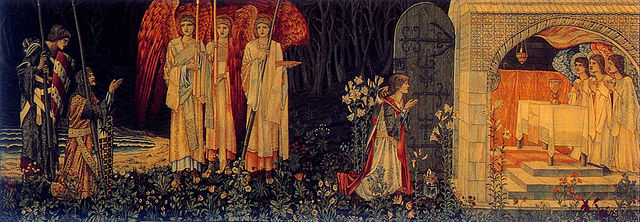Narrative structure of The Lord of the Rings
Scholars have described the narrative structure of The Lord of the Rings, a high fantasy work by J. R. R. Tolkien published in 1954–55, in a variety of ways, including as a balanced pair of outer and inner quests; a linear sequence of scenes or tableaux; a fractal arrangement of separate episodes; a Gothic cathedral-like edifice of many different elements; multiple cycles or spirals; or an elaborate medieval-style interlacing of intersecting threads of story. Also present is an elaborate symmetry between pairs of characters.
The Lord of the Rings uses many themes of medieval romance (Yvain, le Chevalier au Lion illustrated), such as heroism and interlacing.
The work's structure has been compared to fractals, which unfold and gain complexity by splintering lines and shapes into infinitely complex patterns.
The novel has been likened to a Gothic cathedral, an architectural space that offers multiple vistas, lights, and atmospheres.
Tom Bombadil was a Dutch doll (example pictured) in Tolkien's family. From there, Tolkien wrote a poem, and from that he created the character in the novel.
J. R. R. Tolkien's best-known novels, The Hobbit and The Lord of the Rings, both have the structure of quests, with a hero setting out, facing dangers, achieving a goal, and returning home. Where The Hobbit is a children's story with the simple goal of treasure, The Lord of the Rings is a more complex narrative with multiple quests. Its main quest, to destroy the One Ring, has been described as a reversed quest – starting with a much-desired treasure, and getting rid of it. That quest, too, is balanced against a moral quest, to scour the Shire and return it to its original state.
Allegorical portrait of a knight reaching his princess at the end of his quest. In the background, he kills a dragon. Workshop of Lucas Cranach the Elder, c. 1515–20
Unlike a typical quest like seeking the Holy Grail of Arthurian legend, Frodo's is to destroy an object, the One Ring. Vision of the Holy Grail by William Morris, 1890






